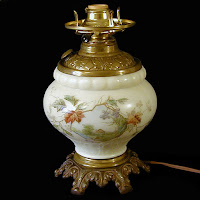Many
people are confused when they see a decorated Wave Crest object. I have heard
people say, "What is this?
Porcelain? Glass? A collector
will immediately identify a piece as Wave Crest but an inexperienced observer is
often confused.
Wave
Crest is glass. It is opal ware glass that people sometimes
call milk glass but it is not the normal everyday milk glass. Most Wave Crest pieces are made in a mold and
if you examine a piece you will be able to detect the mold lines. This thin
transparent opal ware glass was
manufactured by many different glass houses including Mount Washington Pairpoint. The undecorated glass called blanks was sold
to decorating houses for embellishments.
C F Monroe was one of the largest and most well know of the decorating
factories employing many skilled well known artists.
 |
| Two Sided Shell Shaker #351 |
|
 |
| Swirl and Bulge Shaker #72 |
|
 |
| Tulip Shaker #73 |
|
As a first step in the decorating process, C F
Monroe, often put these undecorated pieces into an acid bath with the result being
a lusterless soft finish called satin
glass because the glass felt like satin to the touch. Only a few pieces of Wave Crest have been found with an untouched
shiny glossy finish. After the acid bath, many pieces were painted with a
pastel matte finish, light blue, pink, yellow background and then the true splendor of
Wave Crest began. The decorating!
 |
Cracker Jar #352
white ground, hand painted |
|
 |
Cracker Jar #402
blue tinted ground, hand painted |
|
 |
Cracker Jar #404
pink tinted ground, hand painted |
|
Charles
Monroe employed some of the best skilled artists, including Carl V.
Helmschmied, Walter Nilson, J.J. Knoblauch, Joseph Hickish, Carl Puffee, Flora
Fiest, Gustave Reinman, Florence Knoblauch, Emil Melchior, and Alma Wenk,
Blanche Duval, Gussie Stremlan, Elizabeth Zeibart, and Elizabeth Casey. These artists decorated the glass with a gradient
degree of difficulty and design that C. F. Monroe sold by categories called assortments.
Assortment 1: consisted of decorations on a
white ground that was then glazed, this was the least expensive.
 |
| Bulbous Necklace Shaker |
The shaker on the left is an exception, it was purchased as blank by the C.F. Monroe and decorated with an applied transfer of orange, blue, and brown flowers. Today, only a few pieces of glossy items have been recorded and because these items are rare, they often demand a fairly high price. It is named Bulbous Necklace in Lechner's book, "
The World of Salt Shakers, volume 2."
Assortment 2:
consisted of decorations on a tinted ground glaze.
Assortment 2 1/2: consisted of decorations on a tinted ground with a fired bisque finish.
Assortment 3:
consisted of decorations on a tinted ground glaze with more elaborate designs.
Assortment 4: consisted
of decorations on a tinted ground with a bisque finish.
Assortment 5 consisted
of decorations on a tinted ground with a bisque finish, the designs were traced in
gold.
Assortment
6, consisted of decorations, traced in gold and were described as "very
elegant and striking."
Special
order and totally hand painted pieces demanded the highest price and were the
most time consuming to paint. Transfers
were used to lessen the cost and the time required to paint the items. Sometimes both techniques were used on the same item, a transfer
was applied first and then the artist would add a few hand painted dots, flowers, or scrolls.
 |
Hand painted lamp base with
a house by a lake |
|
 |
Hand painted lamp base with
sailboats on a lake |
|
 |
Hand painted lamp base with
flowers |
|
 |
Draped Column Shakers #98
only tinted on bulbous base,
glossy column |
|
 |
Wave Scroll Shakers #383
yellow tinted ground
|
|
 |
Shasta Daisy Shaker
flowers
|
|
A trade
advertisement states, "Wave Crest is the most wonderful line ever
put on the market. The trimmings are all 24 carat gold plate, and the finish
and workmanship of the best, the decorations being hand painted and of numerous
designs to meet the tastes of all." There was a very large assortment of
Wave Crest items produced including vases, bowls, biscuit/cracker jars, pin
dishes, salt and pepper shakers and jewelry boxes. Some of the rarer items
include sugar sifters, napkin rings, paper weights, whisk broom holders, wig
holders and lamps. These pieces were made for everyday use and of course,
over time many were broken or just thrown away.
 |
Sugar Sifter #53 AA
white ground, hand painted |
|
 |
Jewel Box #425
pink ground, hand painted |
|
 |
Jewel Tray #424
yellow ground, hand painted |
|
Wave
Crest pieces that were highly decorated and hand painted were most popular from
1890 to 1910 with C. F. Monroe at the forefront, being the largest producer of
decorated opal ware. However, demand for
this type of glass began to wane and C. F. Monroe went out of business in 1916. Today Wave Crest items demand a rather high
price due to the limited supply and the beautiful decorations.
In 1996, a group of collectors formed the, "Wave Crest Collectors
Club," to study the wares decorated by the C. F. Monroe Company. Check out their website: wavecrestcollectorsclub.org
Below is an example of the same shaker pattern
decorated with different finishes and flowers.
 |
Sash Shaker
white background,
hand painted pink flowers |
|
 |
Sash Shaker
yellow background,
hand painted blue flowers |
|




















No comments:
Post a Comment